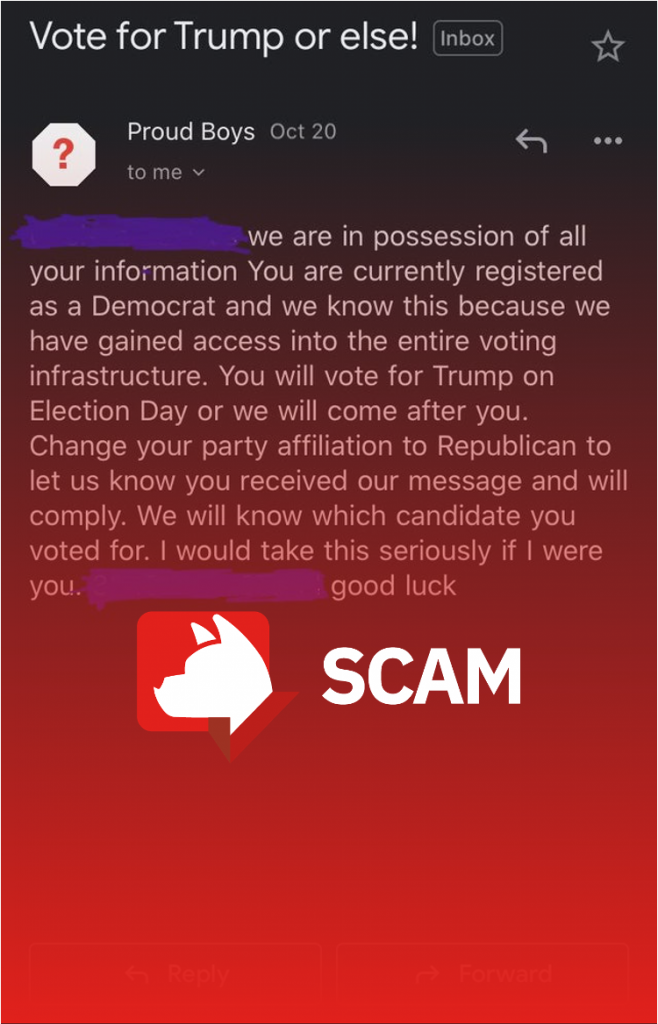Election Day is approaching. Did you vote? Here are some common scams you should be aware of during voting season.
Common voting scam #1: Threatening emails
Threatening emails appeared as the latest tactic of voting scam.

Many voters received emails in which scammers claimed that they know the recipients’ personal information. With that, scammers would threaten recipients to vote for specific candidates – trying to scare voters that can further manipulate the election.
How to deal with threatening emails?
- Ignore these emails and check the safety status of your email regularly.
- The existence of these emails is to scare voters in order to sway the election. Please note that knowing only your email and name does not count as ‘hacking’.
- If you’d like to check if your email is leaked, simply use Trend Micro ScamCheck. Send the email address you want to check; Trend Micro ScamCheck will show results in seconds!
Common voting scam #2: Phishing texts: Fake voter polls
Have you ever received text messages like this?

Strange text messages sent in the name of polls are common, especially when the election day is near.
In this kind of text message, scammers would tell recipients to participate in online polls/surveys, offering attractive rewards such as fiat, gift cards, or gifts. No matter how good the deal is, or how simple the task may seem, these messages have one thing in common: a suspicious link.
Links included in this type of scams are usually phishing or malicious. When the recipient clicks the link, scammers behind the messages could potentially gain access to the person’s device, steal financial information, threaten privacy by activating the camera secretly, or install malware on the device.
How to deal with phishing text messages?
Do NOT click any URLs from unknown sources. Always check before clicking any links. Copy and paste the link, send it to Trend Micro ScamCheck, and let Trend Micro ScamCheck do the rest.
Common voting scam #3: Phishing emails: fake voter registration
Other than phishing text messages, phishing emails are being spread widely as well. Scammers would contact people by email, impersonating Election Assistance Commission (EAC), and ask recipients to click the link provided in the context to register for the voting system or to confirm the registration.
These emails usually contain phishing links. When recipients click the link, a fake website would appear, which asks the person to enter his/her personal data (name, date of birth, mailing address, email address, social security number, driver’s license…etc.). The information could be used for identity thefts afterward.
How to deal with phishing emails?
Whether it is a text message or email, the responsible way to deal with phishing links remains the same:
- Check before you click. (We can’t stress enough the importance of this!)
- Trend Micro ScamCheck would be a great tool to use when dealing with phishing links.
Please copy and paste the links you are unfamiliar with and send them to Trend Micro ScamCheck for verification! It would also be useful to contact the organization listed on the email to ensure content validity. If it is confirmed to be a scam, you can then choose to block the sender to terminate future communication.
Common voting scam #4: Phone scams (fundraising)
Nowadays, there are more and more cases of phone scams on fundraising campaigns. In phone scams, scammers would pretend to be political volunteers, reaching out to people to request certain candidates’ donations.
How to deal with phone scams?
- Hang up and CHECK before you take any action.
- Confirm with the organizations directly to see if the fundraising campaign is real. A decent organization should have an official channel for fundraising. That said, please remember to NEVER give money to individuals or organizations you don’t recognize.
- You can also use caller ID APPs to see who the caller is before you answer.
Vote early, vote safely. And, stay cautious at all times.
Click on the button below to try Trend Micro ScamCheck for free now:
